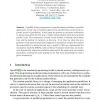Free Online Productivity Tools
i2Speak
i2Symbol
i2OCR
iTex2Img
iWeb2Print
iWeb2Shot
i2Type
iPdf2Split
iPdf2Merge
i2Bopomofo
i2Arabic
i2Style
i2Image
i2PDF
iLatex2Rtf
Sci2ools
WOMPAT
2004
Springer
2004
Springer
Runtime Adjustment of Parallel Nested Loops
OpenMP allows programmers to specify nested parallelism in parallel applications. In the case of scientific applications, parallel loops are the most important source of parallelism. In this paper we present an automatic mechanism to dynamically detect the best way to exploit the parallelism when having nested parallel loops. This mechanism is based on the number of threads, the problem size, and the number of iterations on the loop. To do that, we claim that programmers must specify the potential application parallelism and give the runtime the responsibility to decide the best way to exploit it. We have implemented this mechanism inside the IBM XL runtime library. Evaluation shows that our mechanism dynamically adapts the parallelism generated to the application and runtime parameters, reaching the same speedup as the best static parallelization (with a priori information).
Distributed And Parallel Computing | Nested Parallelism | OpenMP Allows Programmers | Parallel Loops | WOMPAT 2004 |
| Added | 03 Jul 2010 |
| Updated | 03 Jul 2010 |
| Type | Conference |
| Year | 2004 |
| Where | WOMPAT |
| Authors | Alejandro Duran, Raúl Silvera, Julita Corbalán, Jesús Labarta |
Comments (0)

